Every Irish person has an idea of Greece and - depending on your age and interests - they probably include blue skies, beautiful islands and chic resorts, or perhaps ancient temples and shrines, revered philosophers, and world-changing history.
But what about the food? We don't talk enough about how good – and how good for you – Greek food actually is, or how their farm-to-table culture strongly resembles our own and how it can result in some of the greatest (and healthiest) meals of your life.
Although the Greek influence on Irish literature is unmistakable shouldn't it be a stronger influence on our cooking too?
On this trip - which was my first - I spent the majority of my time on Crete, the largest of all the Greek islands, along the way enjoying some of the best meals I've ever sat down to.
I thought I knew Greece through its literature, but only an in-person visit will reveal the real riches waiting to be found there. Arriving in the island's largest city Heraklion (in the company of a very lively American tour group) I was welcomed immediately with a local delicacy, the delicious Kalitsounia pastry.
A feathery soft hand pie made of cream cheese and honey, it's a light/heavy mix of the sweet and savory I became a little obsessed with after my first bite, to be honest. The Greeks clearly know how to make a delicious first impression, so when I think of Crete from now on it'll be as a land of quite literal cheese and honey.

Delicious cheese and honey filled Kalitsounia pastries welcome you to Crete
On our first evening in the port city of Chania, we dined at Apostolis Restaurant in the Old Town, a legendary seafood restaurant that serves as the perfect gathering place for early summer revels. This is where we first discovered the true meaning of Greek hospitality.
We lost count of the endlessly arriving courses – including, eventually, a melt-in-the-mouth dessert made of fried cheese and honey called sfakiani that served as a nightcap. Between all the substantial plates and the flying raki shots, by midnight, you could probably have rolled us home.
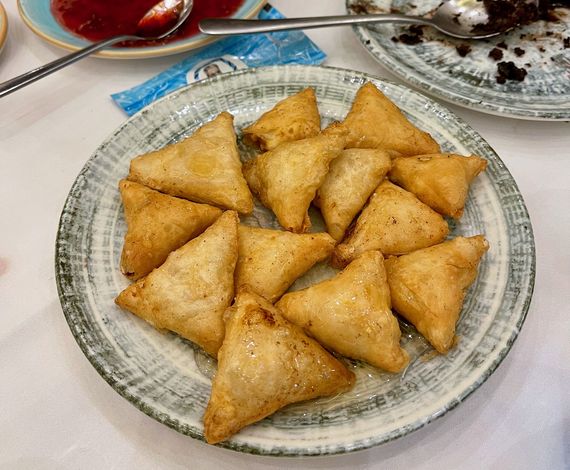
Freshly made sfakiani at Apostolis Restaurant in Crete.
Crete is a quietly fascinating place, I discovered. I have never been somewhere where I felt so foreign and yet so completely at home. So was this some kind of past life recall? Or was it all down to the raki?
I don't have the answer but I can tell you that my spirit was at ease in Crete in a way that I took note of. I felt restored to myself, reborn even. So this trip was not just a highlight of the year but of my life, I think. I really didn't expect that, but I wasn't resisting.
Featuring microclimates that run from temperate to the subtropical, Crete offers visitors everything from superb mediterranean dining at venues like the Carte Postale Restaurant overlooking the city of Chania, to outrageously upscale luxury resorts like Villa Cavo Dago, which affords expansive panoramas of the Aegean sea.
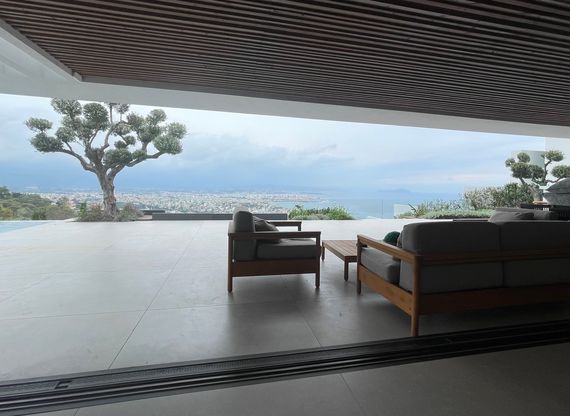
The luxurious Villa Cavo Dago overlooks the Aegean sea
If for any strange reason like football or Guinness you should find yourself homesick for the old sod, Crete has got you covered with, by my count, no less than twenty Irish bars scattered across the island.
Young Irish college students seem to choose Crete as a perfect destination for summer work experience and who could blame them? It has both beauty and value for money written all over it.
Affordable hotels, like the chic Halepa Hotel, are conveniently located just minutes from the center of Chania and offer the calmer pace of the Halepa district which you may welcome after the buzz of the city center, which is just a short walk away.
If you're the robust type then know that Crete is a haven for adventure holidays. You can enjoy island-wide hiking along the craggy shorelines or even trek up into the mountains - expect to meet many hearty Germans in sensible shorts and hiking boots – or alternatively, there's kite surfing, sea diving, and coastal speedboat trips too.
That last option saw us whizzing off from the seaside town of Chora Sfakion one morning to take a fast boat to otherwise inaccessible coastal villages like Loutro and the memorable Taverna Dialiskari located in the Marmara harbor.
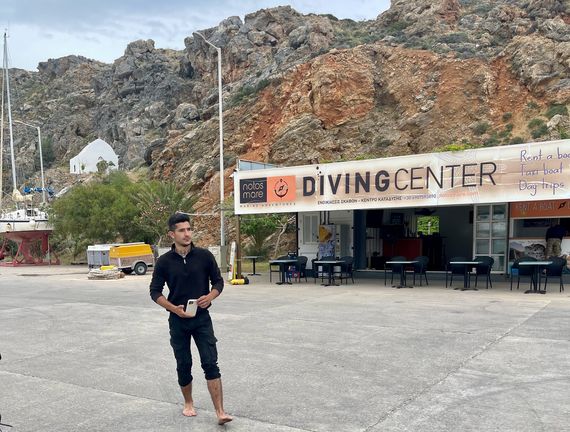
Catch a fast boat at Chora Sfakion to visit Taverna Dialiskari
Sniffing around the kitchen at Taverna Dialiskari I immediately ordered the fried lamb with homemade chips (french fries) and they did not disappoint, resulting in one of the best meals that we had in Crete with the sea air sharpening our appetites.
In between courses, you could literally hop in the sea – and many did – because the taverna is right on the water's edge, so it feels off the grid and yet chic in the way this island often does.
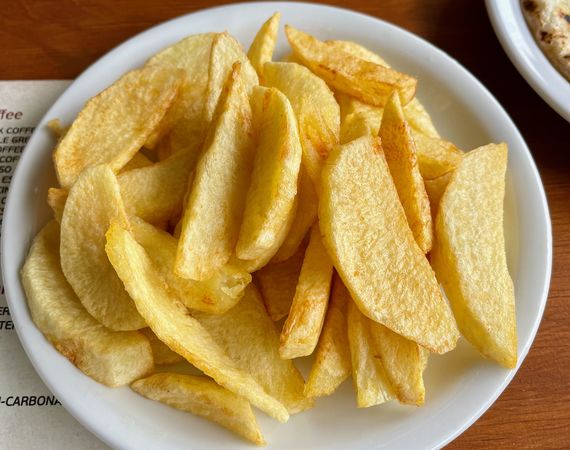
Freshly made fried potatoes at Taverna Dialiskari are worth a trip
It turns out that Crete really knows how to craft a truly unforgettable vacation, but so too does the wily National Tourism Offices of Greece who invited five other fabulous, flinty US travel writers along with me on this magical mystery tour to see what Greek island life is all about.
First-time visitors will notice the natural beauty of the island, which features endless miles of pristine coastline for bathing and sunbathing, olive groves and orange groves (almost anything you can plant flourishes here), and rugged mountain ranges or stylish fully catered seaside resorts.
But the biggest revelation to me was the Cretan people. Warm and friendly like the Irish, they know how to inhabit the modern world whilst keeping faith with centuries of tradition and culture. No wonder I felt so at home.
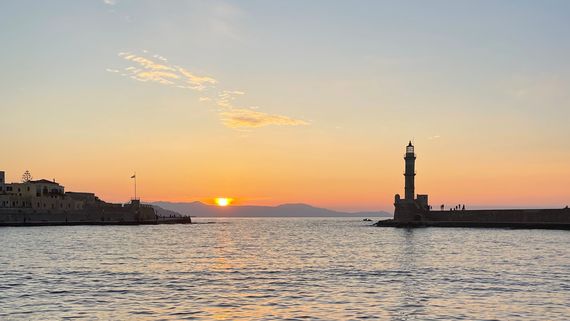
Sunset over Chania, Crete
Our next stop, Mila Mountain Retreat and Restaurant was a place of astonishments where sustainable dining in a mountain setting is the attraction. Freshness that only comes from locally sourced produce was the watchword here and you can also stay in one of their luxury outback digs for a back-to-nature visit.
It's easy to see how myths about the gods who live in the mountains got started in Greece. Just spend 20 minutes under a leafy canopy overlooking the surrounding hills and you'll feel the genius of the place under your feet. Looking about it really would not have surprised me to see – as the poet Cavafy once did – a god descend from those “most venerable” halls in the clouds.
In all my travels I have only found this kind of immanence in Japan and Greece – alongside Ireland, of course – where the line dividing us from the otherworld is at its thinnest. No wonder I fell so hard for the place.
Driving back to the hotel along a steep gorge our driver suddenly stopped and told us to step out. The view of the valley below was impressive from this height but what happened next was one of the most beautiful things that I've ever seen: an aerie of golden eagles soared about twenty feet over our heads, one after another, gliding effortlessly in the gentle updraft, their immense wings fully extended, each of them looking haughty and regal and huge.
It was heart-stopping to see them glide above me one by one, and I counted twelve overpasses before I just gave myself up to the beauty of the experience. My heart was in my chest to be this close to such grace and beauty, it was one of the most awe-inspiring moments of my life I think; the memory of it will never leave me. It was worth the air ticket alone.
Like Ireland, Crete has a revolutionary history, which we explored at the Eleftherios Venizelos Museum, the once home of a key leader of the Greek national liberation movement and a charismatic elder statesman of the early 20th century. The pride taken in his life and achievements is evident in the tour guides faces, no translation was needed (although the tour is given in English).
It was on then to the nearby Taverna Leventogiannis. Located in the historic village of Therisso in Chania, it offered a delicious, gourmet traditional Cretan banquet, serving up plate after plate of authentic Cretan recipes, appetizers, main courses and flowing raki. Another highlight of a trip already filled with them.
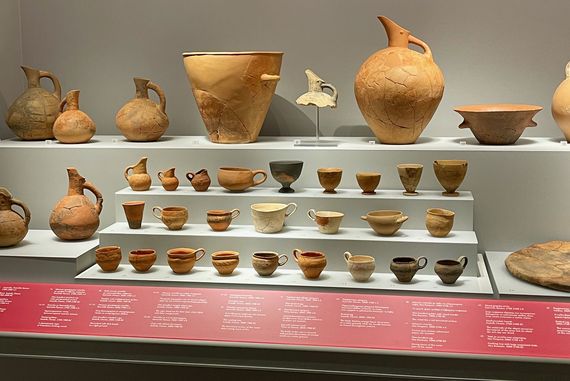
Chania Archaeological Museum tells the story of Crete from its earliest inhabitants
The next day, we visited the Chania Archaeological Museum, a personal wonder of the trip for me (please don't miss it if you visit). The museum tells the story of Crete from its earliest inhabitants with a focus and quiet scholarship that I found fascinating. The venue itself is an architectural triumph that will delight both scholars and tourists eager to delve a little deeper into the remarkable island they're visiting.
Onward then to Gouverneto Monastery. Here, you descend a giant gorge to a hidden church carved into the cliff face. The sea stretches out blue in front of you as you descend and you can progress all the way down to the water's edge if you wish to, passing all the wild goats that abound here with their strange otherwordly eyes. It's a memorable spot that would appeal to the hardier visitor - early Christians made it a gathering place to evade capture and you'll soon see why.
(Irish tip: bring a hat everywhere you go in Greece or suffer the inevitable Irish sunburn that no sunscreen can prevent!)
At Vinolio Creta, we were invited to sample the olive and grapes that are at the heart of the company’s superb wine and olive oil products set in the grounds of an old Venetian monastery. Discerning gastronomes and wine aficionados will enjoy the excellent offerings and the history here, and the olive oil is delicious.
But let's catch our breaths for a moment. Consider, as I often did during this trip, that Greece gave the world democracy, the modern alphabet, the Olympic games, classical philosophy, western theatre, even maps – but they still wear their history and achievements rather lightly, never taking themselves too seriously, whilst making room for every pastime under the sun. That's some trick.
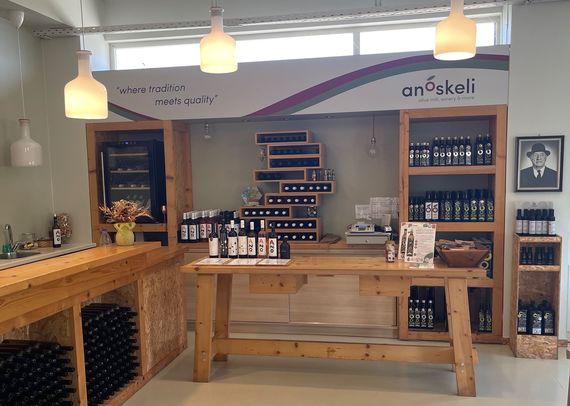
Anoskeli Winery Olive Mill is a must experience on any Crete visit
Our next stop was the verdant Anoskeli Winery Olive Mill, a company on a mission to produce and deliver the world's best extra virgin olive oil and wine from Crete in a sustainable manner. I was there for about ten minutes before I had to concede they have succeeded in both. Offering tastings to visitors, their olive oils have an intense and fruity flavor profile I adored.
Traveling on at the breakneck speed of a event packed press trip, where the pace only slowed when we were among the islanders, things became much more serene at Anoskeli Winery Olive Mill when we sampled the olive oils that seemed to have the summer still alive in them.
On this trip, I discovered Cretan cooking is sophisticated but unpretentious, insisting on the primacy of fresh ingredients, most locally sourced and paired with their superb local wines. And everywhere we traveled we were offered feta so fresh it surpassed Italian burrata and mozzarella (that's not a small boast).
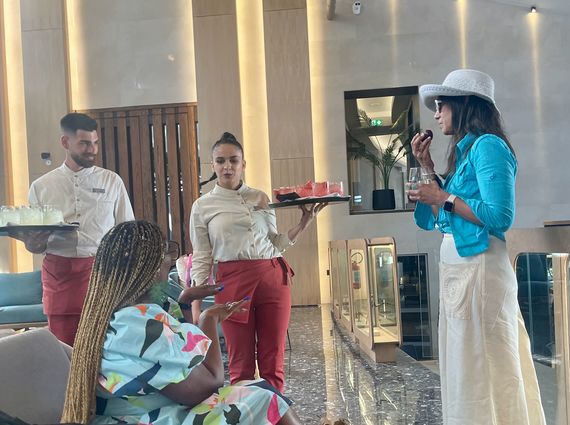
Welcome cocktail at the Nautilux Hotel are an event in themselves
Next up came the two highlights of my Cretan trip. The Nautilux Hotel, a glamorous all-inclusive resort hotel in Rethymno that seems to have combined the words naughty and luxe to deliver on both counts. Think of a White Lotus setting with every possible luxury amenity (including breakfast, lunch and dinner) where all that's left to do is relax.
I adored the chic rooms and the airy lightness of the wider hotel, which is fun to walk around and which manages the design trick of being both substantial in size and intimate in feeling, you'll probably want to book your next stay as you're checking out.
That evening we all arrived at Agreco Farm, a classic taverna/restaurant and olive oil producing company overlooking the blue Aegean sea that highlights and exemplifies the traditional Cretan diet.
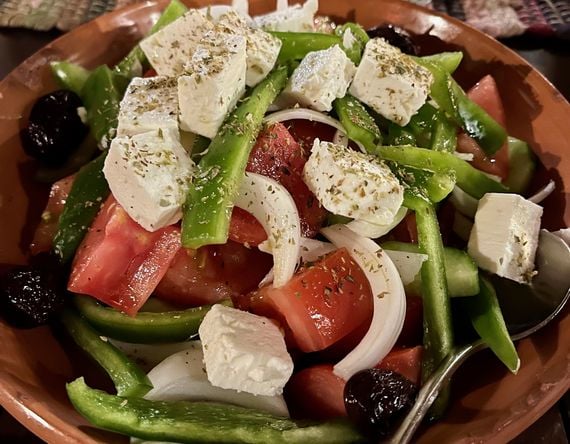
A locally sourced and delicious Greek salt at Agreco Farm
Sitting down to one of the best meals I had not just in Crete but in my life, this was a banquet such as Lord Byron might have enjoyed on a fabled 18 century grand tour. If you only make one local dinner booking in wider Crete, make it here.
Rethymno is the name of the charming city on the north coast of Crete and in its old town a Venetian Harbor is filled with fishing boats and lined with atmospheric tavernas. Picture a Greek town that has remained markably preserved over centuries, yet that still offers fun nightlife options for a pacier crowd.
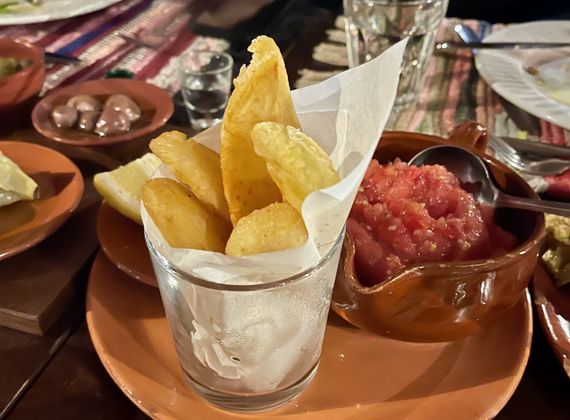
They serve sumptuous multiple course meals at Agreco Farm
The Pepi Boutique Hotel in the old town combines discreet elegance with value and location. From suites to superior rooms the emphasis is on comfort and affordability. It's an adults only hotel of 13 rooms, 3 Junior Suites and 2 Suites surrounded by a beautiful garden and a small outdoor swimming pool.
We stopped after that to visit Giorgos Hatziparaskos, the Last Phyllo Master of Greece. He has richly earned the impressive moniker. Inside a simple Venetian house with high, white walls, this artisan has been working ultra-thin pastry by hand since the Second World War (he's about 86 now). That's a long apprenticeship so no wonder his pastry is divine.
After these exertions under the sun, our group retired to Avli, a white linen table restaurant and hotel which boasts fine dining in the Cretan style. A standout moment in a trip already brimming with unforgettable meals and moments, the dishes they brought to our table were not just consistently flavorful but plated so beautifully that they often go viral on Instagram.
Already a world-renowned restaurant, Avli also offers ten luxurious suites, an enticing wine cellar and a traditional Cretan products shop. The watchwords are here are local and sustainably sourced and you'll feel the care they take in every visit.
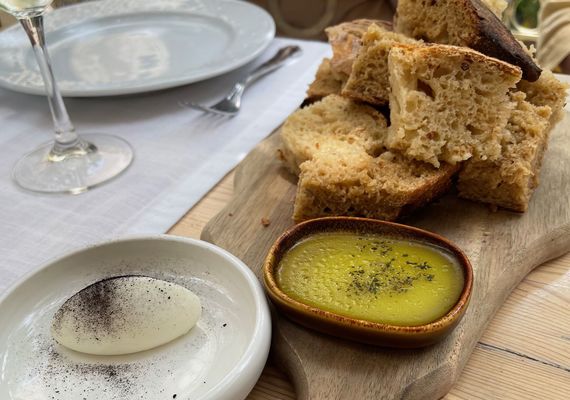
Avli Hotel and Restaurant locally sources its fresh produce
Later that evening, we visited the 7 Seas or 7 Thalasses Restaurant and Hotel in Rethymno. Each dish that arrived surpassed the previous one in a truly romantic by-the-sea setting. On top of the great food was the great service, with a staff so welcoming and attentive that the night was a blur of fun and fine dining.
The next day we arrived at Plakias Resort, an all-inclusive luxury resort featuring multiple bars and restaurants – a total vacation spot. Beach chairs and sun umbrellas are provided and you can order a cocktail here at any time of day, which is very civilized. There are other gorgeous beaches located nearby so if you want maximum relaxation and low stress, this is the spot. You'll probably return over and over.
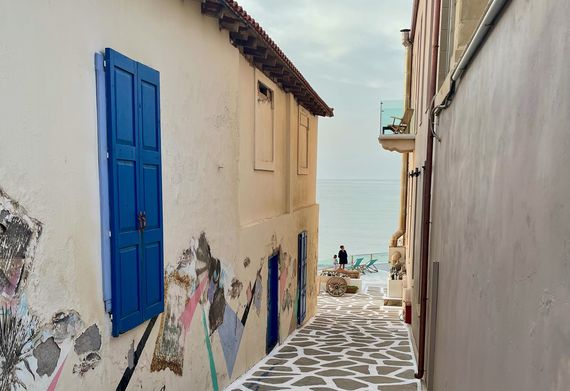
The path to 7 Thalasses Restaurant and Hotel
For me one of the most charming meals of the entire trip was served at Pastos Escape Traditional Taverna, in operation in the small town of the same name since 1933. Here Ms Maria as she is known serves course after course of feta, salads, olive oils, cheeses, wine, fried lamb, baked lamb, pilaf, fried potatoes, casseroles and kaltsounia and sfakiani pies, a reminder that the Cretan diet is not just healthy but gourmet.
On our last night we dined in the village of Meronas, a place continually inhabited since Minoan times that has long developed its own unique customs and traditions. Surrounded by the tall mountains associated with the old gods, it embraces its past and future by offering outstanding local fare at off the beaten path prices. (And do make a point of sampling the ice cold well water that flows clear off the mountain when you visit).
Here's what I discovered in Greece: Irish people have a cultural advantage on a trip here. The spirited chat of the old famers will remind you of home, you'll correctly guess that the elderly ladies who run the local restaurants can cook and bake dishes to fully restore your five senses, you'll feel the pull and wildness of the landscape all around you the same way we do at home, and you'll be – in every sense - in your element.
The only other truly useful thing to know is that the Greek word for Sláinte! is Yamas! Happy travels.
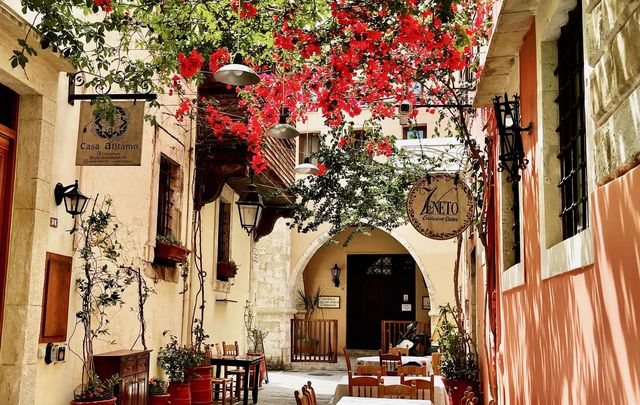



Comments